Arrival in Quito
Arrive at Quito´s international airport. Upon landing at Quito airport, you will be met by the VIP Staff at the jet bridge. Assistance and fast track across immigration and customs. Your guide will be in the arrivals area to take you to your hotel.
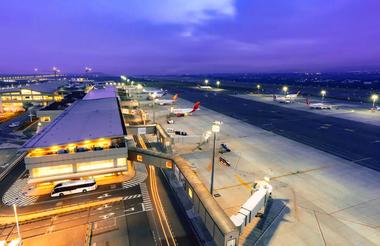


About your transfer
Our Operations department monitors all flights. If their schedule changes, you do not need to alert us as we will arrange your transfer accordingly to the new schedule.Your transfer might take approximately 40 minutes if your hotel is located in the Colonial Quarters. For hotels near the airport, the transfer might take about 25 minutes.
- Quito’s average temperatures range from 53°F at night to 72°F Fahrenheit on sunny days and drop to 45°F at night in the highlands. It is recommended to dress in layers with a warm jacket if your arrival flight is at night.
Quito Colonial & El Alabado Archaeological Museum
Immerse yourself in the rich history and culture of Ecuador with a visit to Quito's Historical Center, recognized as the largest and best-preserved in South America and declared a UNESCO World Heritage Site in 1978. Stroll through the hilly cobblestone streets, admiring centuries-old Spanish-style residences and gardens, as you make your way to the Plaza Grande, the city's central hub. Here, marvel at the Presidential Palace, City Hall, Archbishop's Palace, La Compania Church, Quito's Cathedral, and the Centro Cultural Metropolitano, a cultural center displaying temporary art exhibitions.
Next, experience the captivating Pre-Columbian past at the Archaeological and Art Museum "Casa del Alabado," a colonial residence housing over 400 pieces dating back to 4000 years ago. Choose from a regular guided visit or one of the thematic visits that delve into burial rites, mythological animals, Andean cosmogony, and the wisdom of plants, showcasing the integration of the three worlds and the impact of these ancient cultures on modern-day Ecuador. Get a glimpse into the fascinating cosmos vision of the indigenous people and discover their rich ancestral beliefs and rituals.

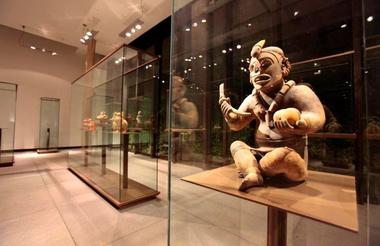

About your city tour
- Additionally, please keep in mind that this tour involves a considerable amount of walking, so be sure to wear comfortable and supportive shoes for the journey.
- It is also important to note that the availability of the thematic visits and the order of visits may be subject to change based on government regulations, building restoration work, weather conditions, or other unforeseen circumstances. In such cases, your guide will work to offer alternative experiences to ensure that you have a memorable and enjoyable time.
Dinner reservation only :
We strongly advise our guests to arrange private transportation for dinner to optimize their experience. Please do not hesitate to contact us directly for assistance, or alternatively, you may arrange a taxi through your hotel concierge.
12:30
Lunch reservation at Ines Restaurant
13:30
Pick up from the lobby
Transfer out to the airport
Check out of the hotel and meet your guide for a private transfer to Quito Airport on time for your flight. Once at the airport, your guide will assist with your luggage and check-in.
AM | Arrive at Baltra Island Airport
You’ll need to rise early this morning to catch your flight to the Galapagos. All our flights to the Galapagos originate in Quito heading on to the islands. For this itinerary, you will be landing on the island of Baltra.
Quasar staff will wait for you at Quito or Guayaquil airport for assistance. Please see detailed instructions under the "Expert Tips tab" if your transportation to the airport has not been booked by QuasarEx.
Upon landing at Baltra´s airport, where a representative from the VIP Lounge will meet you and guide you through the necessary paperwork and luggage collection. While you wait, you can relax in the lounge and enjoy some drinks and light snacks. Once you're ready, you'll meet your bilingual naturalist guide.
After passing through Galapagos National Park inspection your National Park Guide will be there to greet you, holding a sign with the name of your yacht. Your guide will accompany you on the short bus ride to the waterfront. During WWII the island of Baltra was a US Air Force base and one can still see the remnants of the old foundations left behind from that era. We transfer via panga dinghy to the waiting Grace. The crew will see that your luggage is transferred to your cabin.
At the dock, we board a dinghy (panga) to make the short crossing to Grace. You only need to bring your carry-on luggage on the panga as our crew will transfer your luggage to your cabin. You’ll have time to settle into your new home for the week before assembling to review safety procedures and coming events with your Galapagos National Park Guide. While this is taking place the Grace will start her engines and set off into the archipelago.
PM | Santa Cruz Island: Bachas Beach
At the north end of Santa Cruz Island is Las Bachas, comprised of two sandy white-coral beaches that are are major egg-laying sites for sea turtles. The official story of how Las Bachas got its name comes from the Galapagos National Park. During WWII the US military discarded two barges on the beaches. When the first settlers to the area following the war arrived they mispronounced barges as bachas, resulting in the name. There are other explanations of how the location got its name having to do with indentations left in the sand by both egg-laying sea turtles and their departing hatchlings, but we will go with the Park’s.
We go ashore on the white sandy beach and are greeted by patrolling blue-footed boobies. A brief walk inland takes us to a lagoon where pink flamingos are often found along with great blue herons, common stilts, brown noddies, white-cheek pintail ducks, and migratory birds. Snorkeling today is from the beach and you can also enjoy a swim in these waters, which are typically warmer than in other places in the Galapagos.
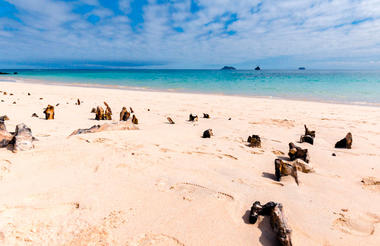
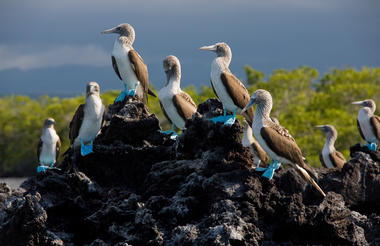

IMPORTANT: If you arrive at the airport more than two hours before departure please wait for our representative to arrive to assist you with check-in. Our representative will have important documents (including your INGALA transit card) waiting for you at the airport, which you will need in addition to your ticket, so please do not check yourself in for your Galapagos flight unless absolutely necessary. You should only check yourself in if you are unable to find our representative less than an hour prior to departure.
Flying to Galapagos
- The maximum baggage allowance is one 23 kg (50 pounds) checked piece of luggage and one carry-on/handbag of 10 kg (22 pounds). This applies only to Avianca Airlines.
Weather in Galapagos
- If you are traveling from late December to June during the warm and wet season, you might expect hot weather with temperatures ranging from70°F (21°C) to 80°F (27°C). The hotter months are March and April.
- The rest of the year, June to December, Galapagos has a cooler or dry season. During the day, especially in the early morning, you might expect occasional mist (garua). August is the coldest month. Temperatures in this season range from 65°F (18°C) to 75°F (23°C)
Activities
a.m. | Morning: Fly to Baltra in the Galapagos Islands and board Grace
- Type of Landing: N/A
p.m. | Late Afternoon: Bachas Beach
- Type of Landing: Wet
- Activities: Hikes
AM | Genovesa Island: Prince Phillip’s Step
Tower Island could serve as a film set for a remote secret submarine base. The southwestern part of the island is an ocean-filled caldera ringed by the outer edges of a sizeable and mostly submerged volcano. The island sits to the northwest, slightly removed from the rest of the archipelago. It is also known as Bird Island, a name it lives up to in a spectacular way.
Our first landing is Prince Phillip’s Steps, named for a visit by the British Monarch in 1964. The dry landing begins at the base of this 25-meter (81-foot) stairway leading up to a narrow stretch of land that opens out onto a small plateau. This is actually a small peninsula that forms the southeastern section of the island. Red-footed boobies wrap their webbed feet around branches to precariously perch in the bushes where they nest. In contrast, their masked-booby cousins dot the surface of the scrublands beyond. Crossing through the sparse vegetation, you will come to a broad lava field that extends toward sea cliffs that form the island’s southern edge. The cavities and holes that have been eroded into the fragile lava are an ideal nesting ground for storm petrels. There are two species, the Galapagos petrel, which is active by day, and the wooden petrel, which feeds at night. The petrels flutter out over the ocean in swarms, then return to nest in the cracks and tunnels of the lava field but not without hazard. Short-eared owls lay in camouflaged wait here and make their living feeding off the returning petrels. After completing the two-hour hike we return to the vessel to change into our wetsuits for some snorkeling at one of the best sites on the islands.
By Phillip’s Steps, along the cliffs that form the protected southern bay of the Tower’s caldera, we enter the water into another world. The first thing you will notice when snorkeling here is very large tropical fish. These are warm water fish feeding off cold water nutrients. You’ll find the full assortment here including an oversize parrot, unicorn, angel, and hogfish along with schools of perch, surgeonfish, and various types of butterflyfish. Hiding in and around the rocky shoreline that drops off into the caldera you will also see a rainbow assortment of wrasse, basslet, anthias, and tang. This is the place to bring your underwater tropical fish identification chart. There are some special treats to be found here including occasional visits by fur sea lions. This area of the bay is also excellent for some kayaking in the calm waters close to the shore to observe nesting birds and you might like to go out for a spin after lunch, before our next landing across the bay to the north.
PM | Genovesa Island: Darwin Bay
Landing on the white coral sands of Darwin Bay and walking up the beach, you find yourself surrounded by the bustling activity of great frigate birds. Puffball chicks and their proud papas—who sport bulging scarlet throat-sacks—crowd the surrounding branches, while yellow-crowned herons and lava herons feed by the shore. Farther along you will discover a stunning series of sheltered pools set into a rocky outcrop. Watch your step for marine iguanas, lava lizards, and Galapagos doves that blend with the trail. The trail beside the pools leads up to a cliff overlooking the ocean-filled caldera, where pairs of swallow-tailed gulls, the only nocturnal gulls in the world, can be seen nesting at the cliff’s edge. Lava gulls and pintail ducks ride the sea breezes nearby.
A brief panga ride brings us to the base of those same cliffs to reveal the full variety of bird species sheltering in the ledges and crevices created by the weathered basalt. Among them, red-billed tropicbirds enter and leave their nests trailing exotic kite-like tails. This is also an intriguing place to go deep-water snorkeling. The center of the caldera is very deep and attracts hammerheads and large manta rays which sometimes patrol the western edge of the caldera that is more open to the sea. You can snorkel here gazing down into the depths where you just may spot these large animals if you are fortunate. But don’t worry, if you don’t really want to see them there is the equally amazing and far more sheltered snorkeling experience across the bay.
Right around sunset, we will leave Tower to set out across the archipelago to the far western islands. Remember to watch the inner bay at sunset as you might spot a giant manta ray.

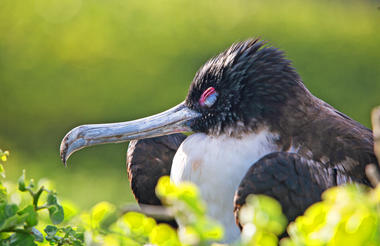

Activities
a.m. | Morning: Prince Phillips Steps.
- Type of Landing: Dry
- Level of Walk: Moderate
- Other Activities: Nature Hikes, Snorkeling, Panga Ride & Kayaking
p.m. | Late Afternoon: Darwin Bay Type of Landing: Wet
- Level of Walk: Moderate
- Other Activities: Nature Hikes, Snorkeling, Panga Ride & Kayaking
AM | Santiago Island: James Bay
In the morning we make our way along the northwestern shore of Santiago Island to South James Bay (Puerto Egas), which offers access to three unique sites. One landing is on a black beach with intriguing eroded rock formations inland. A trail crosses the dry interior eastward and rises to the rim of an extinct volcanic crater; cracks within it allow seawater to seep in, which then dries to form salt deposits that have been mined in the past. Darwin describes his visit to South James Bay in Voyage of the Beagle.
Another path leads south, where hikers are treated to a series of crystal-clear grottos formed of broken lava tubes. These are home to sea lions and tropical fish. This is the best place in the islands to see fur sea lions lazing on the rocks by the grottos. Further to the north, another landing and path lead to a series of inland lagoons, home to flamingos. Birders coming to James Bay will have the opportunity to spot vermillion flycatchers, Galapagos hawks and the tool-wielding woodpecker finch. Puerto Egas is a good spot for taking pictures—the light for photography is perfect at either dawn or sunset. The lava and the black sand seem to catch fire and the animals acquire a surreal and lovely quality. The marine iguanas that inhabit the area resemble Samurai warriors and can easily be seen grazing on seaweed in the more shallow pools of the grotto.
James Bay is a snorkeling site that is accessed from the shore instead of a dinghy. The sandy beach slopes off into a rocky bottom where a multitude of sea turtles like to hide by blending in with the rocks. But these rocks move and will swim right up to you. At certain times of the year, large schools of golden rays and spotted eagle rays also glide by. Both fur sea lions and California sea lions occasionally pass through as well.
PM | Santiago Island: Espumilla Beach & Buccaneer’s Cove
In the afternoon visitors to Espumilla Beach come in search of birds rather than freshwater. The short walk up the beach leads inland to a mangrove typically inhabited by the Common stilts. Beyond the mangroves is a brackish lagoon where flocks of pink flamingos and white-cheeked pintails wade in search of mollusks. The trail makes passes over a tiny hilltop through a sparse Palo Santo forest before looping back to the beach. Galapagos finches and Vermilion flycatchers inhabit the area.
The tuff formations that form the cliffs that surround the cove have created a natural sculptor gallery rising from the sea with formations including the Monk and Elephant Rock. An audience of hundreds of seabirds looks down upon the gallery from surrounding cliffs. Buccaneer Cove and Espumilla Beach offer one of the more dramatic kayaking routes in the Galapagos for paddlers looking for a challenge.
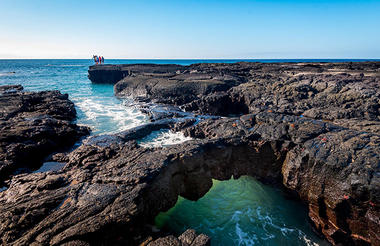
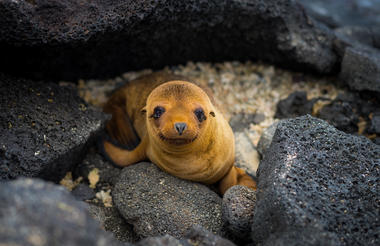
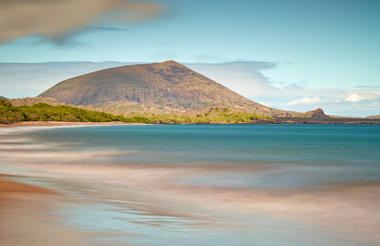
Activities
a.m. | Morning: James Bay
- Type of Landing: Wet
- Level of Walk: Moderate
- Other Activities: Nature Hikes & Snorkeling
p.m. | Afternoon: Espumilla Beach Type of Landing: Wet
- Level of Walk: Easy
- Other Activities: Nature Hikes, Snorkeling, Panga Ride & Kayaking
AM | Isabela Island: Punta Vicente Roca
Located at the ‘mouth’ of the head of the sea horse, which forms the northern part of the Isabela is Punta Vicente Roca. Here the remnants of an ancient volcano form two turquoise coves with a bay well protected from the ocean swells. The spot is a popular anchorage from which to take panga rides along the cliff where a partially sunken cave beckons explorers. Masked and blue-footed boobies sit perched along with the point and the sheer cliffs, while flightless cormorants inhabit the shoreline. The upwelling of coldwater currents in combination with the protection of the coves makes Punta Vicente Roca one of the archipelago’s most sought-after dive spots.
One cove is only accessible from the sea by way of an underwater passage. The passage opens to the calm waters of the hidden cove where sea lions laze on the beach having traveled along the underwater route. The entire area of Punta Vicente Roca lies on the flank of 2,600 foot Volcano Ecuador. This is the island’s sixth largest volcano. Half of Volcano Ecuador slid into the ocean leaving a spectacular cutaway view of its caldera. The site offers deep water snorkeling where sea lions turtles, spotted eagle rays, and even manta rays are the attraction. After our visit here we set off south and west across the Bolivar channel. Keep your eyes open in this best place in the islands for spotting whales.
Isabela is the largest island in the archipelago, accounting for half of the total landmass of the Galapagos at 4,588 square kilometers. Though narrow in places, the island runs 132 km from north to south or 82 miles. Isabella is formed from six shield volcanoes that merged into a single landmass. It is also home to the highest point in the Galápagos, Wolf Volcano at 1,707 meters (5,547 feet), and calderas of up to 20 kilometers (12½ miles) across.
PM | Isabela Island: Tagus Cove
We head north along the western coast of Isabela Island, to Tagus Cove, named for a British warship that moored here in 1814. Historically the cove was used as an anchorage for pirates and whalers. One can still find the names of their ships carved into the rock above our landing, a practice now prohibited. The cove’s quiet waters make for an ideal panga ride beneath its sheltered cliffs, where blue-footed boobies, brown noddies, pelicans, and noddy terns make their nests, and flightless cormorants and penguins inhabit the lava ledges.
From our landing, a wooden stairway rises to the trail entrance for a view of Darwin Lake; a perfectly round saltwater crater, barely separated from the ocean but above sea level! From the air one can see that both Tagus Cove and Darwin Lake are formed from one, partially flooded, tuff cone on the eastern edge of the giant Darwin volcano.
The cove is formed by a breached and flooded section of the crater with Darwin Lake forming the very center of the same cone. The trail continues around the lake through a dry vegetation zone and then climbs inland to a promontory formed by spatter cones. The site provides spectacular views back toward our anchorage, as well as to Darwin Volcano and Wolf Volcano to the north.
While one does not normally think of greener pastures when planning to go snorkeling, that is exactly what you will find at Tagus Cove. The carpet of green algae that covers the floor of the cove gives the impression of a submerged pasture, and that is just what it is. You can find marine iguanas grazing the algae along with numerous sea turtles gliding and munching their way along. Because the cove opens to the rich waters of the Bolivar Channel this is one of the best snorkeling sites on the island. You also have a good chance of snorkeling with underwater feathered friends including Galapagos penguins and rare flightless cormorants. For those who want to dive deeper, special rewards are waiting for you at 3 meters where camouflaged creatures await, including scorpionfish nestled against the outcrops and sea horses masquerading as twigs of the seaweed waving in the currents. The rare Port Jackson shark can also be found here. Kayakers can enjoy a paddle around the cove, offering excellent views of nesting birds on the cliff walls above.
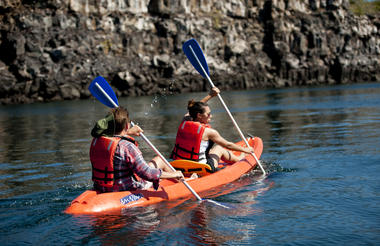
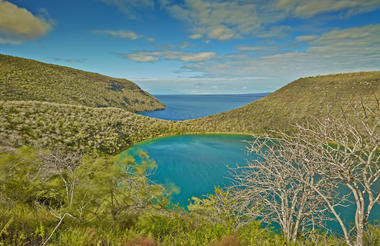
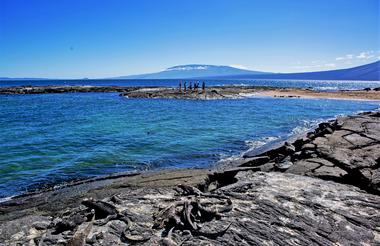
Activities
a.m. | Morning: Punta Vicente Roca
- Type of Landing: Wet
- Level of Walk: Easy
- Other Activities: Snorkeling, Panga Ride
p.m. | Afternoon: Tagus Cove Type of Landing: Dry
- Level of Walk: Moderate
- Other Activities: Nature Hikes, Snorkeling, Panga Ride & Kayaking
AM | Fernandina Island: Punta Espinosa
Fernandina is the youngest and westernmost island in the Galapagos. It sits across the Bolivar Channel opposite Isabela. Our destination is Punta Espinosa, a narrow spit of land in the northeast corner of the island, where a number of unique Galapagos species can be seen in close proximity. As our panga driver skillfully navigates the reef, penguins show off by throwing themselves from the rocks into the water. Red and turquoise-blue zayapas crabs disperse across the lava shoreline, while great blue and lava herons forage through the mangrove roots. The landing is a dry one, set in a quiet inlet beneath the branches of a small mangrove forest. A short walk through the vegetation leads to a large colony of marine iguanas—a schoolyard of Godzilla’s children—resting atop one another in friendly heaps along the rocky shoreline, spitting water to clear their bodies of salt. Nearby, sea lions frolic in a sheltered lagoon.
Dominating this landscape from high overhead looms the summit of La Cumbre, 1,495 meters (4,858 feet), one of the most active volcanoes in the world. Farther down this stretch of shore, the world’s only species of flightless cormorants have established a colony near an inviting inlet frequented by sea turtles. Because these birds evolved without land predators—it was easier to feed on the squid, octopus, eel and fish found in the ocean—the cormorants progressively took to the sea. They developed heavier, more powerful legs and feet for kicking, serpent-like necks and fur-like plumage. Their wings are now mere vestiges. Back toward the landing and farther inland, the island’s black lava flows become more evident, forming a quiet, inner mangrove lagoon where you will spot rays and sea turtles gliding just below the surface. Galapagos hawks survey the entire scene from overhead.
The snorkeling off Punta Espinoza offers some real treats, as many of the creatures you just saw on land, including the Godzilla-like marine iguanas, flightless cormorants, Galapagos penguins and sea lions await you in the waters of the point (which incidentally was used as a set during the making of Master & Commander). A key feature of the ocean bottom here is the troughs formed by volcanic rock and ocean currents. Because these waters reach out into the Bolivar Channel they can be quite cold. Sea turtles like to hang out in the warm water of the troughs. You’ll also see marine iguanas ferrying back and forth between underwater grazing areas and their colonies onshore. This is an excellent place to see underwater iguanas munching on algae. If you are fortunate you may catch a glimpse of a flightless cormorant demonstrating its swimming abilities or watch a Galapagos penguin zip by. You will feel the difference in ocean temperature and watch the water get clearer as you move from the more protected shallow areas out into the cold-rich waters of the channel. The Bolivar Channel is the very best place in the Galapagos to see dolphins and whales. On rare occasions, our groups have been able to swim with dolphins, kayak with melon-headed whales, and even spot the elusive sperm whale.
PM | Isabela Island: Urbina Bay
Urbina Bay is directly west of Isabela’s Volcano Alcedo, where we will make an easy, wet landing (a hop into a few inches of water) onto a gently sloping beach. In 1954, a Disney film crew caught sight of this gleaming white strip and went to investigate. To their astonishment, three miles (5 km) of the marine reef had been uplifted by as much as 13 feet (4 meters) prior to their arrival. They discovered schools of stranded fish and other creatures in newly formed tidal pools along with the skeletons of sea turtles and sharks unable to make it to the ocean as a result of the uplift event. Alcedo erupted a few weeks later.
Now visitors can walk amongst the boulder-sized dried coral heads, mollusks, and other organisms that once formed the ocean floor. A highlight of this excursion is the giant land iguanas, whose vivid and gaudy yellow skin suggests that dinosaurs may have been very colorful indeed. Giant tortoises inhabit this coastal plain during the wet season, before migrating to the highlands when it turns dry. Our landing beach provides a nesting site for sea turtles and will also provide you with opportunities to snorkel amongst marine creatures, or just relax onshore. Here we must take care not to step on the sea turtle nests dug carefully into the sand. For those looking for snorkeling from a beach, this is the place, with tropical fish hiding amongst the rocks to the north side of the bay. This evening you have a real treat as the Grace sits at anchor in the Bolivar Channel where you will be spectacularly surrounded by the towering shield volcanoes that form Fernandina and Isabela. Sunset in the channel is also an excellent time to spot whales and dolphins that feed in these productive waters created by the upwelling of the Cromwell Current, while you enjoy a happy hour at the Sky lounge on the upper rear deck.
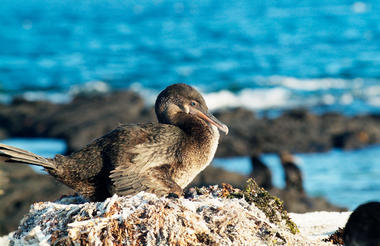
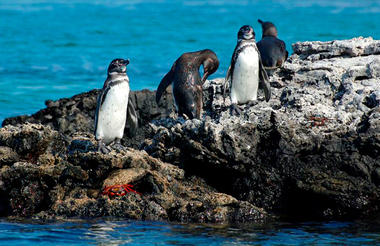
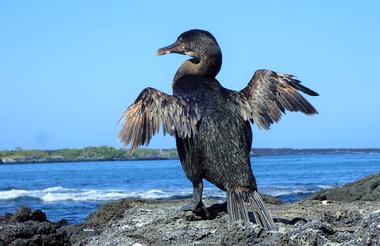
Activities
a.m. | Morning: Punta Espinoza
- Type of Landing: Dry
- Level of Walk: Moderate
- Other Activities: Nature Hikes & Snorkeling.
p.m. | Afternoon: Urbina Bay Type of Landing: Wet
- Level of Walk: Easy
- Other Activities: Nature Hikes & Snorkeling
AM | Isabela Island: Elizabeth Bay
Continuing our voyage south along the west coast of Isabela we enter the outer part of Elizabeth Bay where we come upon a tall rocky islet that is home to a colony of Galapagos Penguins. Looming to the south is the Sierra Negra volcano that forms the southern part of Isabela Island. In 2018 glowing rivers of lava lit up the night as they flowed down the flank of Sierra Negra toward Elizabeth Bay, where some of our lucky passengers had a front-row seat on one of the archipelago's most spectacular performances.
In contrast to the rugged lava fields of Sierra Negra, Elizabeth Bay is one of the most sensitive habitats in the Galapagos. This outing is entire aboard our pangas. The tangle of mangroves' roots that line the Bay, as it narrows to a channel before widening out to the back bay, tend to still the waters making it seem like a giant aquarium while giving the area a green forested look. Spotted eagle rays, golden rays, and sea turtle glide just below the surface with the latter coming up occasionally to breathe. You may see a Galapagos hawk circling high overhead as we drift the calm waters. Approaching the back of the Bay, we bring our panga closer into a cluster of mangroves for a surprise. Sealions use the horizontal trunks of the mangroves as resting areas earning them the nickname tree lions.
PM | Isabela Island: Punta Moreno
We return to the Grace for lunch as she makes her way a bit farther along the coast of Isabela to our next visitors’ site, Punta Moreno. You’ll likely be surprised at just how much life you can find in and around a Pahoehoe lava field. In 2018 Sierra Negra Volcano, which looms over the entire southern part of the island (and really is the southern part of the island) gave the area a fresh coat of glowing lava that reached within 3 miles of our landing site. This is one of the least visited sites in the Galapagos.
Along the shore, you’ll have chances to see Galapagos penguins, flightless cormorants, and a colony of marine iguanas with a reddish tinge that sport the usual mohawk from head to tail. Sally light-footed crabs dot the coast reminding us of the color of molten lava.
This is one of those landing sites where you are best off with sneakers or hiking shoes due to time spent hiking over fields of broken lava (not because of hot lava) and there’s more here than lava lizards and cactus. As we cross the broken fields that sometimes sound like clinking glass, you’ll come upon a little oasis formed by natural pools surrounded by green grasses. These have become home and resting places for a variety of birds including gallinules, pink flamingos, pintail ducks and more.
As we continue along, the trail brings us to a series of coastal lagoons, that again provide a surprising oasis of green including mangrove forests where pelicans nest. Look toward the bottom of the lagoons for resting white-tipped reef sharks, while green sea turtles ply the surface and great blue herons wade the shoreline.
The snorkeling off Punta Moreno above a rocky bottom offers a similar assortment including sea turtles and sea lions mixed in with bumped-head parrotfish, king angelfish and schools of yellow-tailed and surgeon Pacific creole fish and much more.
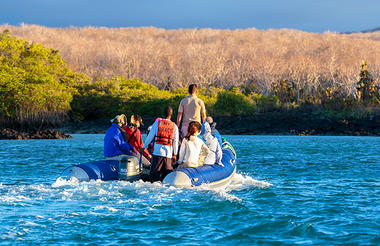
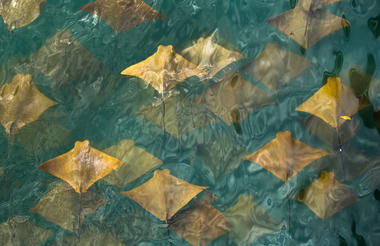
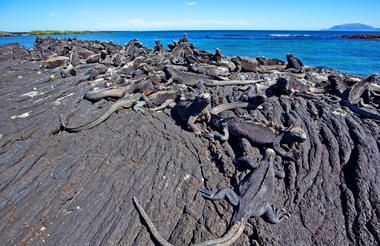
Activities
a.m. | Morning: Elizabeth Bay
- Type of Landing: N/A
- Level of Walk: N/A
- Other Activities: Panga Ride
p.m. | Afternoon: Punta Moreno Type of Landing: Dry
- Level of Walk: Moderate Other Activities: Nature Hikes, Snorkeling & Panga Ride
AM | Isabela Island: Las Tintoreras, Sucre’s Cave, Breeding
Center & Wetlands
Puerto Villamil has a feeling of standing on the edge of the earth. The tiny fishing village, founded in 1897 by Don Antonio Gíl, is something of a forgotten gem in the islands. It has a population of roughly 2,000 people and is set amidst miles of white sandy beaches that rest at the outer edge of Sierra Negra Volcano. Buried pirate treasures have been unearthed here some years ago in the shadow of a tall coconut palm, thereby giving credence to all the legends of hidden treasure buried beneath palm trees.
We visit Las Tintoreras which showcases colonies of sea lions, Galapagos turtles, and iguanas; skates, sharks, penguins, sea cucumbers, urchins, and a myriad members of the native flora and fauna whose peaceful interactions make you question exactly who’s watching who. We continue to Cuevas del Sucre which are fascinating lava formations, caves, and tunnels located in an endemic forest.
PM: Afternoon Navigation to Santa Cruz Island
Before finishing up the morning and navigating in the afternoon, we visit a breeding station for the endemic giant tortoise led by the National Park Service as well as a hyper-saline lagoon frequented by flamingos and other waders and shore birds.
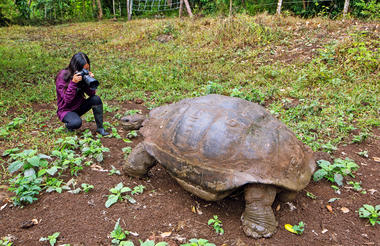
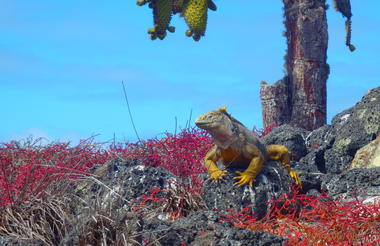
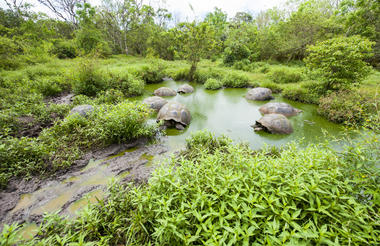
Activities
a.m. | Morning: The Charles Darwin Research Station.
- Type of Landing: Dry
- Level of Walk: Easy
- Other Activities: Shopping in Puerto Ayora
p.m. | Late Afternoon: Highlands. Type of Landing: Dry
- Level of Walk: Easy
- Other Activities: Nature Hikes
AM | Santa Cruz Island: Los Gemelos / Flight Home
We say goodbye to the Grace to take a 40 min. bus ride early in the morning to visit Los Gemelos. The terrestrial world of the tortoise and the underworld of the lava tubes meet at Los Gemelos (the twins). These two large sinkholes craters were formed by collapsed lava tubes. The contrast between the marine desert coast and verdant Lost World look of the highlands is most striking here and you can easily encounter rain even when sun is shining a half an hour away at the coast.
Los Gemelos are surrounded by a Scalesia forest. Scalesia is endemic to Galapagos and many endemic and native species call the forest home. This is an excellent place to view some of Darwin’s famous finches along with the elusive and dazzling vermillion flycatcher.
After visiting Los Gemelos, we continue our bus ride for another 20 mins to the Itabaca channel. We will cross the channel and take a short bus ride to Baltra’s airport.
Upon your arrival in Quito, you will be greeted by your guide, who will accompany you to Chazca Restaurant for lunch.
Following your meal, begin your adventure with a visit to a local shop in Quito that specializes in exquisite alpaca wool garments. Learn about the fine qualities of alpaca fiber, one of the five finest animal fibers in the world. Our partner, Paqocha, is a family business founded in 2006 by Felipe and Lorena, both entrepreneurs. Born from their dedicated work in the páramos of Guamote and the indigenous women from Quichua communities of the Ecuadorian Southern Andes, these women, while managing their daily tasks such as herding alpacas, engage in traditional hand-spinning of alpaca wool. This age-old practice, seamlessly integrated into their daily lives, is being revitalized through Paqocha’s efforts, ensuring mutual appreciation and fair compensation.
While visting the workshop, witness the meticulous process of transforming alpaca fiber into yarn by master artisans who will demonstrate their craft, showcasing the skill and dedication involved in preparing the wool for the weavers. Your visit truly support women weavers in the Andes. These talented artisans create beautiful, high-quality textiles that, through Paqocha. The women find economic opportunities and a means to preserve and celebrate their cultural heritage.
After dinner, our team will ensure your return to the airport for your international flight.
Once at the airport, the VIP staff will assist you with immigration procedures and access to the VIP lounge until it is time to board your flight.
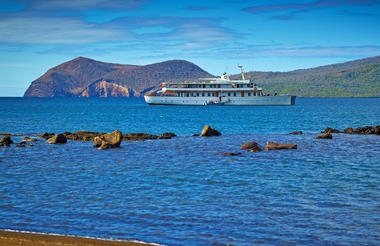
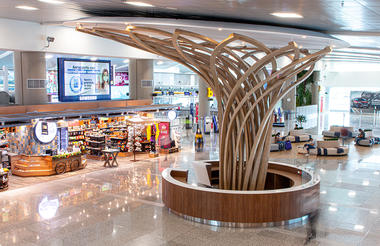
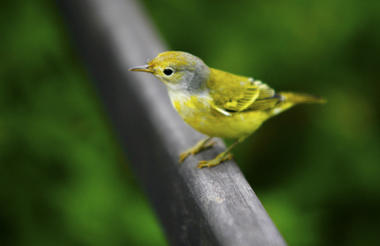
Activities
a.m | Morning: Los Gemelos
- Type of Landing: Dry
- Level of Walk: Easy
- Other Activities: Nature Hikes
Dinner transportation
- Services include private transportation and guide assistance for up to 8 hours.
- We will do our best to accommodate your interest during the service.
- Meals are extra.
15:30
Lunch Reservation at Chazca Restaurant
Afternoon
Paqocha Workshop
19:30
Dinner Reservation at Ciré Cumbayá



